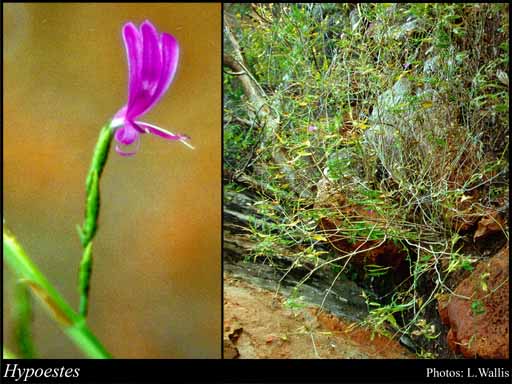- Reference
- Prodr.Fl.Nov.Holland. 474 (1810)
- Name Status
- Current

Scientific Description
Family Acanthaceae.
Habit and leaf form. Herbs, or shrubs (subshrubs, with cystoliths). The herbs perennial. Young stems usually angled or ribbed. Hydrophytic, or helophytic, or mesophytic, or xerophytic. Leaves opposite (pairs connected across node by faint transverse ridge); petiolate; gland-dotted, or not gland-dotted; simple. Leaf blades entire; flat; pinnately veined, or palmately veined; cross-venulate. Leaves without stipules. Leaf blade margins entire. Stem anatomy. Nodes unilacunar. Secondary thickening developing from a conventional cambial ring. Roots. Aerial roots present, or absent.
Reproductive type, pollination. Fertile flowers hermaphrodite. Unisexual flowers absent. Plants hermaphrodite. Entomophilous. Pollination mechanism conspicuously specialized, or unspecialized.
Inflorescence and flower features. Flowers aggregated in ‘inflorescences’. The terminal inflorescence unit cymose, or racemose. Inflorescences terminal, or axillary; consisting of involucres of fused bracts arranged in short or long panicles or spikes or in condensed axillary clusters; with involucral bracts (enclosing at least 2–4 flowers, the involucre consisting of 4 bracts, outer 2 fused at least part of way from base (in Australia) to form a cylinder, inner (bracteoles) 2, inserted at right angles to outer bracts, free from each other but adnate by their midrib to fused part of outer bracts); pseudanthial, or not pseudanthial. The involucres sessile or pedunculate. Flowers bracteate; bracteolate; very irregular; zygomorphic. The floral asymmetry involving the perianth. Flowers 4 merous, or 5 merous; tetracyclic. Free hypanthium absent. Hypogynous disk present. Perianth with distinct calyx and corolla; 9, or 10; 2 -whorled; isomerous, or anisomerous. Calyx 5; 1 -whorled; gamosepalous; lobed; regular (equal); with the median member posterior. Corolla 4, or 5; 1 -whorled; gamopetalous; imbricate, or contorted, or with open aestivation; with narrowly cylindric tube twisted through 180 degrees; bilabiate. Androecium 2. Androecial members adnate; all equal; coherent (basally attached); 1 - adelphous; 1 -whorled. Stamens 2. Staminal insertion in the throat of the corolla tube. Stamens becoming exserted; reduced in number relative to the adjacent perianth; oppositisepalous; all alternating with the corolla members. Anthers dorsifixed; dehiscing via longitudinal slits; unilocular; tetrasporangiate; unappendaged. Pollen shed as single grains. Gynoecium 2 carpelled. The pistil 2 celled. Gynoecium syncarpous; synstylovarious to eu-syncarpous; superior. Ovary plurilocular; 2 locular. Gynoecium median. Ovary sessile. Styles 1; attenuate from the ovary; apical; much longer than the ovary at anthesis. Stigmas 1 (then 2-lobed), or 2 (depending on interpretation of stigmatic area); dry type; non-papillate; Group II type. Placentation axile. Ovules 2 per locule; superposed; non-arillate, or arillate; hemianatropous, or anatropous, or campylotropous.
Fruit and seed features. Fruit non-fleshy; hairy, or not hairy; dehiscent; a capsule (club-shaped, seedless at base). Capsules loculicidal. Fruit elastically dehiscent. Dispersal unit the seed. Fruit 4 seeded. Seeds compressed, globular; non-endospermic; not conspicuously hairy. Embryo well differentiated. Cotyledons 2. Embryo achlorophyllous; curved. Testa with tubercles (tubercles smooth, dimpled). Seedling. Germination phanerocotylar.
Physiology, biochemistry. Aluminium accumulation not found.
Special features. The seeds on elongated, indurated, hook-shaped funicles (‘retinacula’). The upper (posterior, adaxial) lip of the corolla (true lower lip by twisting of tube), 3 lobed; upper (adaxial) lip of the corolla wider, erect, usually with a barred area at base. Lower (abaxial) lip of the corolla entire, or bilobed (then notched); narrow, downturned, reflexed or more or less circinate.
Geography, cytology, number of species. Native of Australia. Not endemic to Australia. Australian states and territories: Western Australia, Northern Territory, Queensland, and New South Wales. Northern Botanical Province.